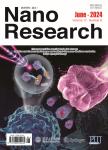MoS2 embedded in 3D interconnected carbon nanofiber film as a free-standing anode for sodium-ion batteries
MoS2 embedded in 3D interconnected carbon nanofiber film as a free-standing anode for sodium-ion batteries作者机构:CAS Key Laboratory of Materials for Energy Conversion Department of Materials Science and Engineering University of Science and Technology of China Hefei 230026 China State Key Laboratory of Fire Science University of Science and Technology of China Hefei 230026 China
出 版 物:《Nano Research》 (纳米研究(英文版))
年 卷 期:2018年第11卷第7期
页 面:3844-3853页
核心收录:
学科分类:12[管理学] 1201[管理学-管理科学与工程(可授管理学、工学学位)] 0808[工学-电气工程] 0809[工学-电子科学与技术(可授工学、理学学位)] 08[工学] 0805[工学-材料科学与工程(可授工学、理学学位)] 081201[工学-计算机系统结构] 0702[理学-物理学] 0812[工学-计算机科学与技术(可授工学、理学学位)]
基 金:This work was supported by the National Key Research and Development Program of China (No. 2016YFB0100305) the National Natural Science Foundation of China (Nos. 21373195 and 51622210) the Fundamental Research Funds for the Central Universities (No. WK3430000004) and the Collaborative Innovation Center of Suzhou Nano Science and Technology
主 题:MoS2 sodium ion batter flexible electrode three-dimensional (3D)interconnected carbon nanofiber
摘 要:As a typical two-dimensional transition metal dichalcogenide, molybdenum disulfide (MoS2) is considered a potential anode material for sodium-ion batteries (NIBs), due to its relatively high theoretical capacity (~ 670 mAh·g--1). However, the low electrical conductivity of MoS2 and its dramatic volume change during charge/discharge lead to severe capacity degradation and poor cycling stability. In this work, we developed a facile, scalable, and effective synthesis method to embed nanosized MoS2 into a thin film of three-dimensional (3D)-interconnected carbon nanofibers (CNFs), producing a MoS2/CNFs film. The free-standing MoS2/CNFs thin film can be used as anode for NIBs without additional binders or carbon black. The MoS2/CNFs electrode exhibits a high reversible capacity of 260 mAh·g^-1, with an extremely low capacity loss of 0.05 mAh·g^-1 per cycle after 2,600 cycles at a current density of 1 A·g^-1. This enhanced sodium storage performance is attributed to the synergistic effect and structural advantages achieved by embedding MoS2 in the 3D-interconnected carbon matrix.



